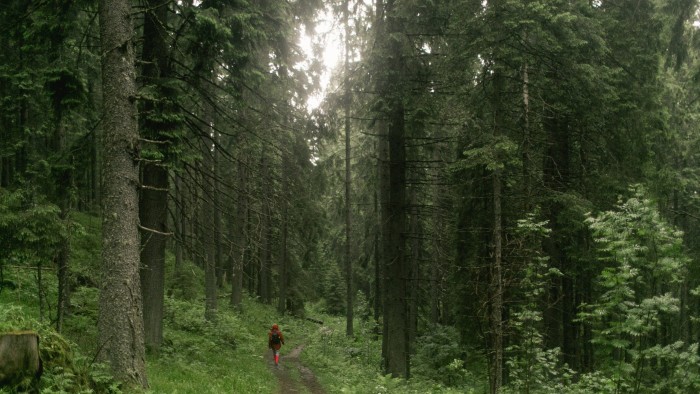Roula Khalaf, Editor of the FT, selects her favourite stories in this weekly newsletter.
Deep in the ancient forests of northern Romania, Nick Thorpe talks woodland management with a grizzled expert nicknamed Ion Barbu: “Beardy John”. The hirsute silviculturist spots a tall fallen fir. It has reached that stage called in German Zerfallsphase — “a period of decay, when large trees fall, but remain important on the forest floor” as generous hosts for fungi and wildlife. Much of the vast terrain Thorpe crosses in this travelogue-cum-history of the mountain range that arcs around south-eastern Europe seems to have arrived at its own Zerfallsphase. The mighty trunks of collapsed systems and societies lie across every path: no longer growing, but not quite dead either.
The Carpathians stretch from Slovakia through Poland, Ukraine and Romania in a “dark ring” or “magnificent horseshoe” some 1,500km long. Thorpe, a BBC journalist and filmmaker, follows their course not in a single trek but through a patchwork of journeys and reports drawn from three decades of knowledge — and love — of these beautiful, past-haunted lands that “groan under the weight of their history”. Wild places, and the creatures they shelter, fill his richly enjoyable narrative. But that titular “wilderness” rather misleads. As Thorpe remarks on a new long-distance hiking route that snakes through Transylvania, “man has shaped these hills and has sown beauty wherever he goes, on purpose or by accident.” Even the bears and wolves live in humanity’s shadow.
From the alder woods of the “Little Carpathians” in Slovakia right round, in an epic loop, to the Iron Gates gorge on the Danube between Romania and Serbia, Thorpe walks or rides through landscapes stained or scarred by bitter history. Episodic and digressive, with leaps from place to place and trip to trip, his book favours colour, character and warmth — which it lavishly delivers — over straight literary lines. Aptly, he champions the rambling intricacy of broadleaf woods against the regimented uniformity of “fast-growing spruce”.
By Western European standards, much of this scenery still looks gloriously unspoilt. Romania holds two-thirds of the continent’s “old-growth forests”: its bucolic Transylvania now attracts not only King Charles (who renovated a house in Zalánpatak) but a rapidly swelling crowd of ecotourists. However, these have always been disputed lands. As a Paris-born green activist tells Thorpe in southern Ukraine, “there was always some kind of imperialism” on hand to blight the idyll of self-sufficiency in tune with soil and climate.
Predatory overlords from Austria, Hungary, Germany and Russia (both Tsarist and Soviet) carved up the Carpathians into imperial or post-imperial blocks, although the hills “have no nationality”. Thorpe experiences the blurred boundaries of highland and woodland identity. Modern nationalism crammed this fluid swirl of peoples — Boykos, Lemkos, Hutsuls, Gypsies, Jews, Saxons — into its rigid frames. Today, “The older you are . . . the narrower the place you identify as home.” Local loyalty may still clash with formal belonging. A riveting passage — one of several written in the aftermath of Russia’s 2022 invasion — shows how Ukrainian draft-avoiders embark on perilous crossings over snowbound peaks into Romania. One explains that, “For me, my family matters more than my country.”
Since the collapse of communism, other beasts roam the hills and valleys. Rapacious foreign investors, along with homegrown cronies, view in these woods, meadows and rivers a resource gold-mine ripe for plunder. Not just in a figurative sense: one of Thorpe’s tales of community pushback against corporate power recounts a campaign to halt the renewal of gold extraction at Roșia Montană in Romania’s Apuseni range, where Roman legionaries once dug. Paradoxically, this classical heritage helped halt plans for a huge opencast pit: “the existence of the old mines saved the region from the killer blow of the new.”
From bears to bees and beers (all play leading roles), Thorpe seeks out the conservers and revivers. He celebrates pioneers who nurture new life from the still-productive “dead wood” of the past, after the big trees of empire and ideology come down. Many, like the Hutsul master carver Yuri in Ukraine, wrestle with a shared dilemma: “How to preserve tradition, without turning it into a trinket for tourists, an imitation of itself?” Thorpe’s question hangs in the clear Carpathian air. Meanwhile, his book — in all its diffuse charm — should draw captivated readers, and visitors, down these beloved winding tracks.
Walking Europe’s Last Wilderness: a Journey Through the Carpathian Mountains by Nick Thorpe Yale University Press £20, 400 pages
Join our online book group on Facebook at FT Books Café and follow FT Weekend on Instagram and X
Source link : http://www.bing.com/news/apiclick.aspx?ref=FexRss&aid=&tid=67a105aaaf0f4385bdbcad5bd1a71499&url=https%3A%2F%2Fwww.ft.com%2Fcontent%2F8156f481-75e3-4f4a-add6-db1ab03f5d3b&c=6192464287935529183&mkt=de-de
Author :
Publish date : 2025-02-03 09:00:00
Copyright for syndicated content belongs to the linked Source.
